Well, I had never been to Memphis, but I’d been to Kansas.
And that’s how I got to Graceland, if you didn’t get the pun. (Listen to “Never Been To Spain” and come back.) The Kansas Jayhawks football team made a bowl game for the first time since 2008. I swore I’d go to the bowl game no matter where it was, and it was in Memphis at the Liberty Bowl, so I as a result I finally got to go to Elvis’ house.
If you know me, you know I have a certain affinity for Elvis. Before I was a Beatles guy, I was an Elvis kid, from way back. While one of the deleted scenes from Pulp Fiction posits you can either be an Elvis person or a Beatles person, I disagree. There is no Beatles without Elvis, and any of the Beatles will tell you that. You catch me on an Elvis day, you’ll be certain I’m not a Beatles person. (But I am a Beatles person most days.)
I have a costume Elvis jumpsuit that is my default Halloween costume, I can do a passable imitation with the voice and the snarl (a few people think I could be an Elvis imitator, if anyone happens to be hiring), and on my previous website I’ve written about the best of his 60’s slapdash movies (it’s Spinout, if you’re wondering). I’ll listen to his SiriusXM channel longer than nearly anyone else can stand, and so on. I had never specifically gone on vacation just to go to Graceland, but I was about three hours away for two weeks in the 80’s, and my parents didn’t feel like making the drive. I often wonder how my interests would have congealed differently had we driven across Alabama to Memphis in 1986. I like college football and sweet tea and Elvis enough without having made that trip.
So when Kansas got invited to the Liberty Bowl, plans were made. I didn’t make the suggestion to go to Graceland, but when the suggestion happened I didn’t turn it down. Reservations were made and we showed up at the Graceland compound.
I say “compound” because you can’t actually drive to Graceland. The house is a separate place across the street from where the museum displays and souvenir stores and parking lots and what have you are located. You park there, get on a bus and get driven across the street to Graceland. There is a stoplight on Elvis Presley Boulevard that is only for buses to go from the compound to Graceland and back again.
One of the most surreal parts was that little 5 minute ride to the house. The musical gates open and you ride through them and up the driveway like a regular ol’ visitor. I just rode in the bus with my mouth open. I’ve seen that trip up the drive a hundred times in Elvis documentaries and there I was, on that road, going to that house. Didn’t even want to take a video or a picture, I just wanted to experience that ride to that house. I think about it now and it still seems unreal.
We got dropped off and watched the introductory video before going inside. Seeing as how “video editor” is my job I watch these things very critically, just like how you watch somebody else do your job. I know they had to make this video for people who don’t really know much about the subject of the video, but I always think- I mean, I know- these things can be done better. The goal is to get you really excited about where you’re going, and these intro videos never do that. This one really missed the mark.
If I were re-making that intro video, I’d do more or less a history on how Graceland was built in 1939, and then go on to how this teenage truck driver with a weird name and even weirder fashion sense and curious singing style took the south by storm and then the nation and within three years bought the place and even as he became a worldwide phenomenon, this oversized farmhouse/wannabe southern plantation became his base for the rest of his life, no matter how much his fame ebbed and flowed.
I mean, they do have a history of Graceland, but it’s after you’ve done the actual tour of the house and are in some of the other buildings of the property. I prefer history shown in context, and I think most people do as well if you actually ask them to think about it. Show me how this place became the centerpiece before you show me the place.
Because knowing what it was before it became Elvis’ house would show you more about why Elvis ultimately bought the place and what he did with it. I heard somewhere along the line that Graceland is “redneck chic” and it makes perfect sense- if you know the history of the place before Elvis bought the place and the history of Elvis before he had enough money to buy the place.
If a poor southern white boy all of a sudden had more money and fame than he knew what to do with, what kind of house would he buy and how would he furnish it? The answer is Graceland. Elvis recorded his first single, “That’s All Right,” at Sun Records Studios in Memphis in the wee hours of July 6, 1954, when he was just 19 years old. On July 2, 1956, less than two years later- after he’d already had two national number one hits, the first rock’n’roll album to ever go to number one on the charts, been on network teevee several times, and signed to a multi-movie deal- he recorded “Hound Dog” and “Don’t Be Cruel,” two of his biggest hits of all time- and he was still barely 21 years old. The next spring, after he’d made his first movie “Love Me Tender” and had like three or four more number ones, only then did he buy Graceland.
We talk about “going viral” nowadays for internet stars. Elvis was the original viral sensation. From nothing to literally WORLDWIDE in less than two years, and you had to pay money to get the full effect of what he did, which meant the cash poured in to Elvis in ways you could never even fathom.
How would you spend money if it came to you in a waterfall? What kind of houses would you buy? How many cars? What kind of clothes would you buy? How about toys? How would you furnish those houses? Would expenses even be a factor? No, of course not. Elvis was born in a shack. His family was so poor that his dad went to prison for forging a 4-dollar check when Elvis was just a boy. When Elvis became that rich that fast, Graceland was the result.
The house is lavish in the “because I can” sense. Carpets on the walls, carpets on the ceiling. Mirrored hallways, multiple teevees in multiple rooms, bright colors everywhere, crystal statues, gold-plated whatever, gadgets galore and no expense spared on any of it.
It simultaneously makes no sense whatsoever and works perfectly. The TV room is bright yellow. The famous “Jungle Room” is basically the interior of a tiki lounge. There is thick green carpeting on the floor, the walls, and ceiling in certain places. There is a stairway completely covered in mirrors, like you’re in somebody’s personal funhouse. And that is because you are.
My favorite room is a room that gets comparatively little publicity compared to the TV room or the Jungle Room or whatever. It’s the billiards room, complete with the pool table he bought in 1960 just after getting out of the army. The walls and ceiling are fabric covered, and the hanging lamp means the light is concentrated over the pool table, making it both gaudy and cozy at the exact same time.
There is so much *stuff* in the Elvis archives it seems like some stuff that should be in more prominent locations, but I don’t know where. Several of the outbuildings on the Graceland side have obviously been turned into exhibit galleries, where they have the receipt for the pool table (it was “reconditioned”- aka he bought it used- and cost $425) and various other paperwork signed by him or his family. Stuff like that, including the remote control for his bedroom TV, one of the first commercially sold remotes.
Also in those galleries is a section devoted to fan art, just a fraction of the hundreds of drawings and paintings that people have made of Elvis… and then off to the side, and in my opinion pretty badly lit, is the only piece of art Elvis ever commissioned of himself in his lifetime. It is a full length portrait done just after he started his residency in Vegas in 1969 by Ralph Wolfe Cowan (whom I have never heard of, but quick research shows this was the kind of stuff he did). He’s wearing all white, with a tied scarf or ascot fluttering in the wind, and the clouds in the background make it seem like he’s being portrayed as a mythic figure (which makes it a little much, even for Elvis).
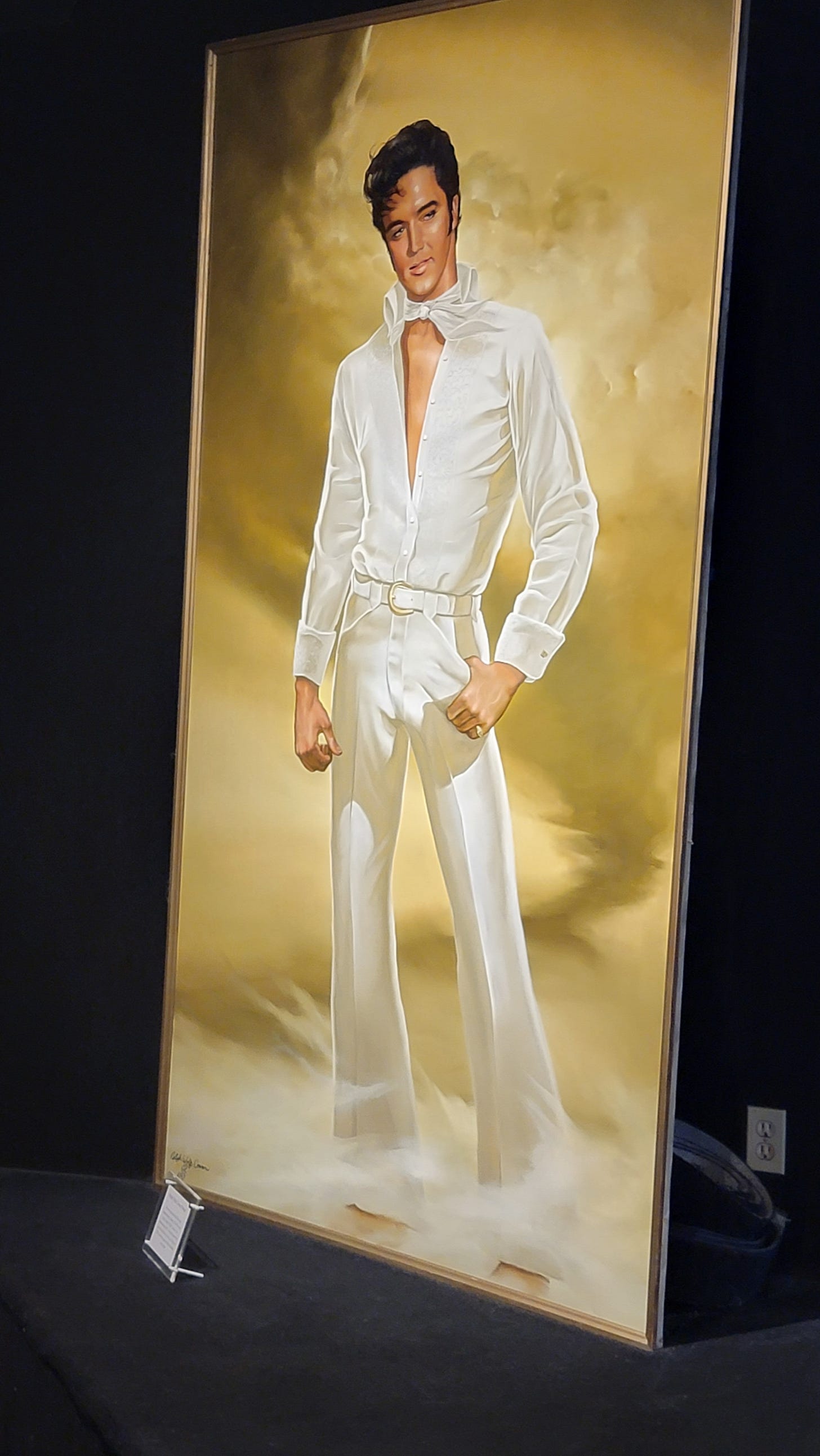
Obviously I am not a professional museum designer, but I come at this from the Elvis fan perspective. Wouldn’t the things that belonged to him, that he chose, that he had a hand in selecting, be worthy of prominent display with attention called to them? You could easily walk by this portrait after all the fan art and not even know it’s the only piece of art he literally actually stood for.
There are other items like this across the street in the compound. One of the more odd irregularities to me was a wall of his gold records from the 50’s. The “Heartbreak Hotel” gold record isn’t there, and that was his first gold record. But there are two for “Wear My Ring Around Your Neck.” How do you miss one and have two of another? And if you’re going to miss one, “Heartbreak Hotel” is a pretty glaring omission, considering how important it is in the Elvis legacy.
Two other items I want to make mention of are actually set up right next to each other. The first is actually an incredibly important piece of rock music history. Remember that list of things that happened to Elvis in that two year period from July 1954 to July 1956? One of them was having the very first rock’n’roll album to top the charts. Well, this display is the actual Presley family copy of that record. It was played by Elvis in the first house he bought, it was played by his family at Graceland when he first got the place, and it was probably played by Priscilla for Lisa Marie when she was a kid, and it was probably played by Lisa Marie herself trying to understand her daddy. It is a physical representation of his fame. I cannot imagine what it would be like to hold a copy of your own album in your own hands for the first time. I cannot imagine how thrilling, stunning, amazing, and scary it would be. This is that album for Elvis. And it’s in like the third or fourth display gallery.
And then, next to it, is one of the most famous suits Elvis ever wore. There is a full gallery of his 70’s concert jumpsuits. There are displays of the various suits he wore during the ‘68 comeback special and other public appearances. But there is only one gold suit. As it turns out, he only wore it a few times in concert and at a photo session right around the time he bought Graceland in 1957.
But they used one of those pictures from that session for a compilation album while he was in the Army, called “50 Million Elvis Fans Can’t Be Wrong,” and the suit became iconic just for that. Elvis hated it, so his manager Colonel Tom Parker kept it until the 80’s, when he sold a bunch of his stuff to the Elvis estate. The suit was part of it, and it’s despite it’s iconic status it is in the third or fourth gallery, right next to the family copy of Elvis’ first album.
There is one other notable item that is hidden on display. It doesn’t even have a card telling you what it is. You either you know or you don’t. There are lots of stories about Elvis, and not all of them paint him in a positive light. One of them is that he shot out his TV’s for one reason or another. Maybe he was bored and maybe he didn’t like what was on. Maybe he picked up a gun instead of the remote. Whatever. Well, one of the exhibit galleries merely has an intro sign that says there are so many items in the collection that they can’t possibly display them all, and here are some things presented without comment. There are various trophies from record sales, fan magazines, programs from his concerts and posters for his movies. And this.
So yeah, the place is more than a little haphazard. But in addition to stumbling on items that should probably be more prominent, there is, like every museum, little gems that wouldn’t make sense in any other location. In museums devoted to a single person or family, I always like little personal items that prove that they are in fact people. And in the days before everything was on the internet, papers and paperwork were a thing. My buddy, the doctor in the first picture, pointed out that for museums in the future they might have to have digital displays like “here’s a ‘like’ they gave to this TokFace video in 2022” as opposed to Elvis’ actual signature on a check or receipt. This also includes newspaper clippings. A mention in the paper used to mean it would get cut out and stored somewhere in a folder or tacked up on a wall. Nowadays, well, you’d have to still read a newspaper. And then you’d have to actually get scissors and cut out the article (I still do this, by the way). Obviously Elvis was a subject of lots of articles in lots of newspapers. Lots of those articles are probably in storage at Graceland, probably in the area near the shot-out TV. But he only kept one article in his wallet. It was not about music, or the movies, or something like that. It was a tiny mention in the Memphis Commercial Appeal that he made black belt in karate. And in the karate display, tucked in a corner in one of the galleries, is that tiny two-inch article from his wallet.
After all that nitpicking, I do want to point out that I spent 5-and-a-half hours at Graceland and the compound across the street and that almost felt like not enough time. We had to kind of rush through the private airplane displays and completely skipped one of the galleries (devoted to Lisa Marie and growing up at Graceland). My doctor buddy spent a lot more time going through his Army career because he is in the military himself. In the end it felt a bit overwhelming because there’s so much to see. If you haven’t been, know it’s not a place you can dip in and out. If you don’t spend the extra to “skip the line” to visit the house you’re going to spend an hour just waiting for the bus.
And there’s still a line for the bus because almost 50 years after he died, Elvis is still a thing. He is the prototype for today’s insta-celebrity culture because of the speed of which he went from nothing to something. Even all those movies, as bad as they might be, keep him present in the culture. Chuck Berry may have been the better musician but he wasn’t in 30 movies, and so it’s hard to stumble upon his magic like you can with Elvis. Even in one of those bad movies you can see why Elvis became Elvis.
And as I mentioned near the top, my favorite of those bad movies is “Spinout.” So as we were nearly done with everything, I had to backtrack to the movie room and find something from “Spinout,” and found one of his coats on display. Not a lot of bad 60’s beach-party-type movies will get recognized as worthy of being in a museum. Of course, Elvis being in it made the difference. And not a lot of “redneck chic” houses become museums. And Elvis, again, made the difference. That alone makes the place worth the visit, whether you’re going to a bowl game or not.





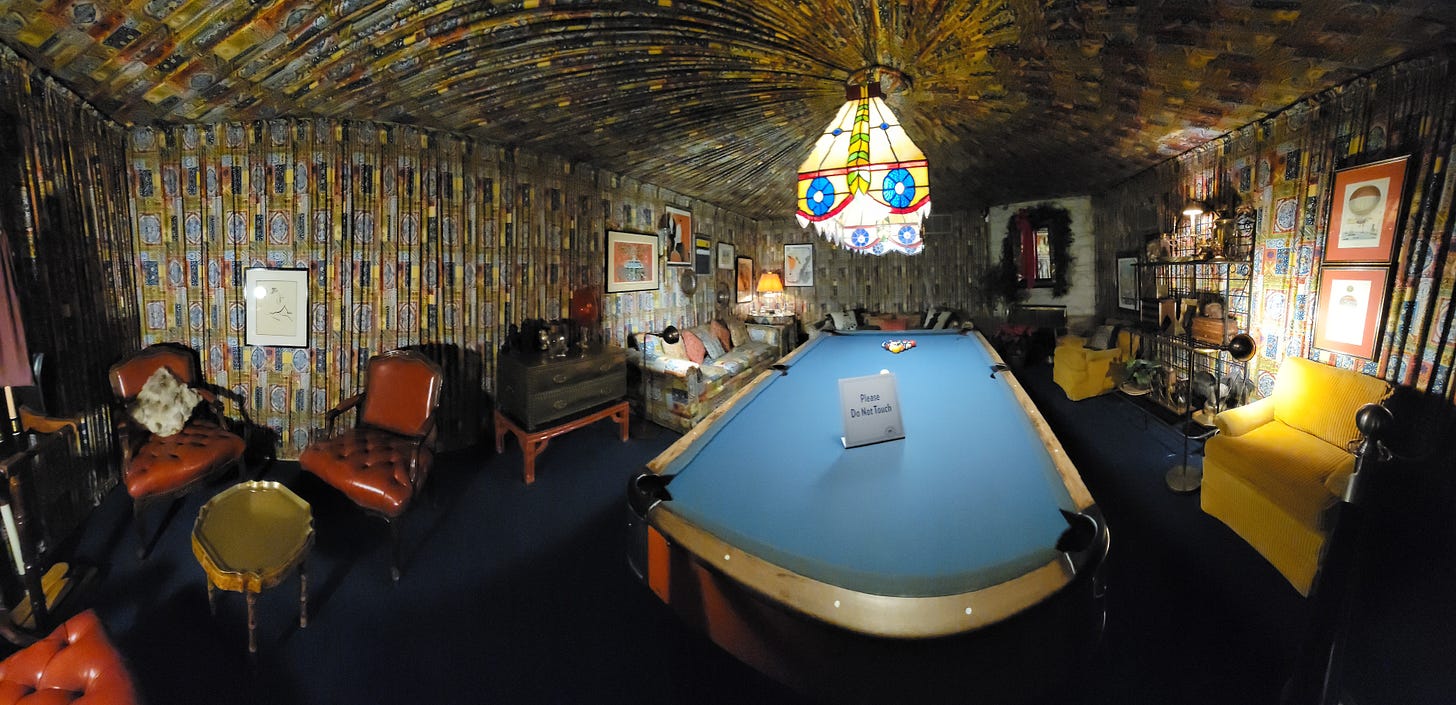
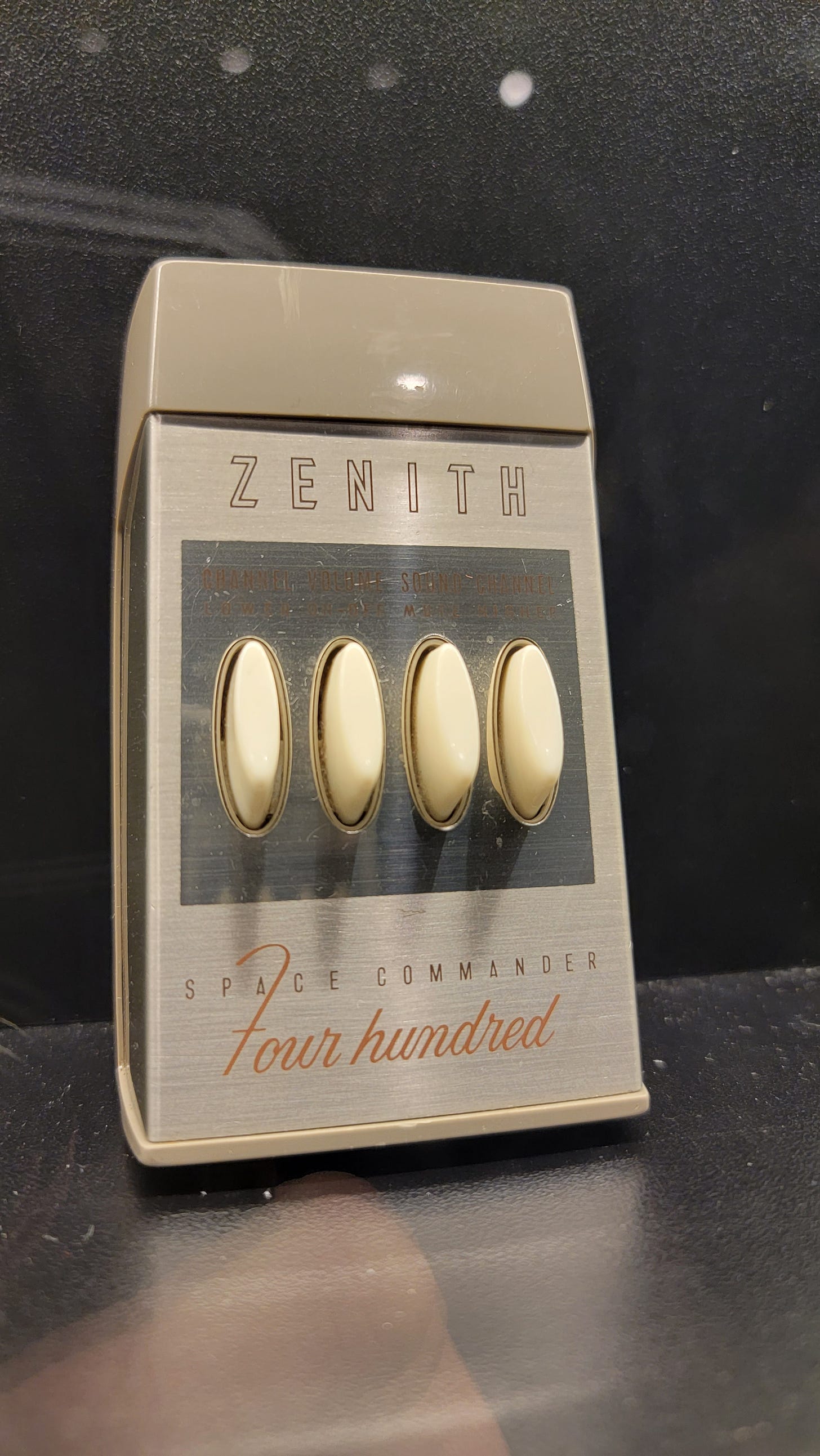
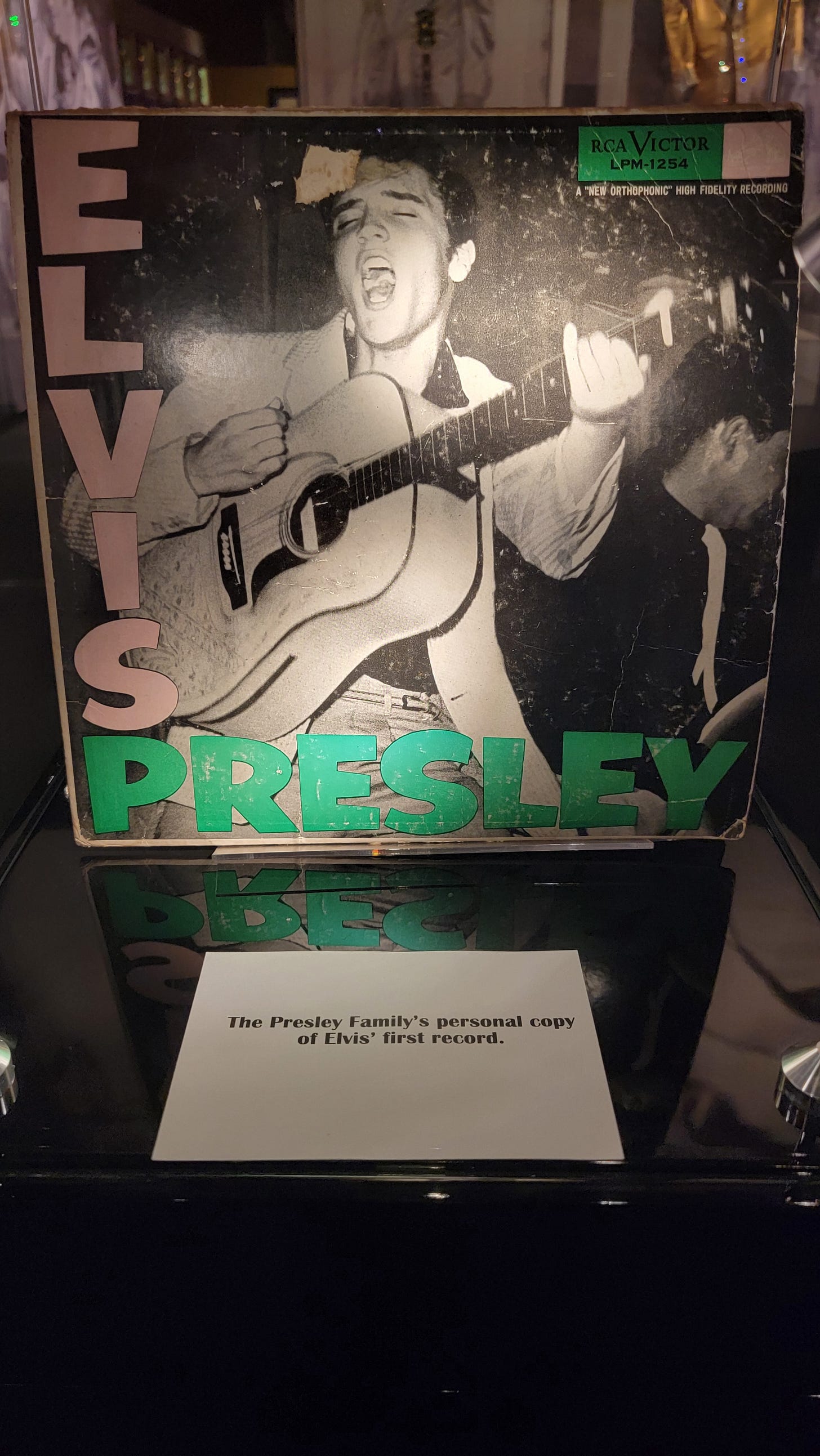
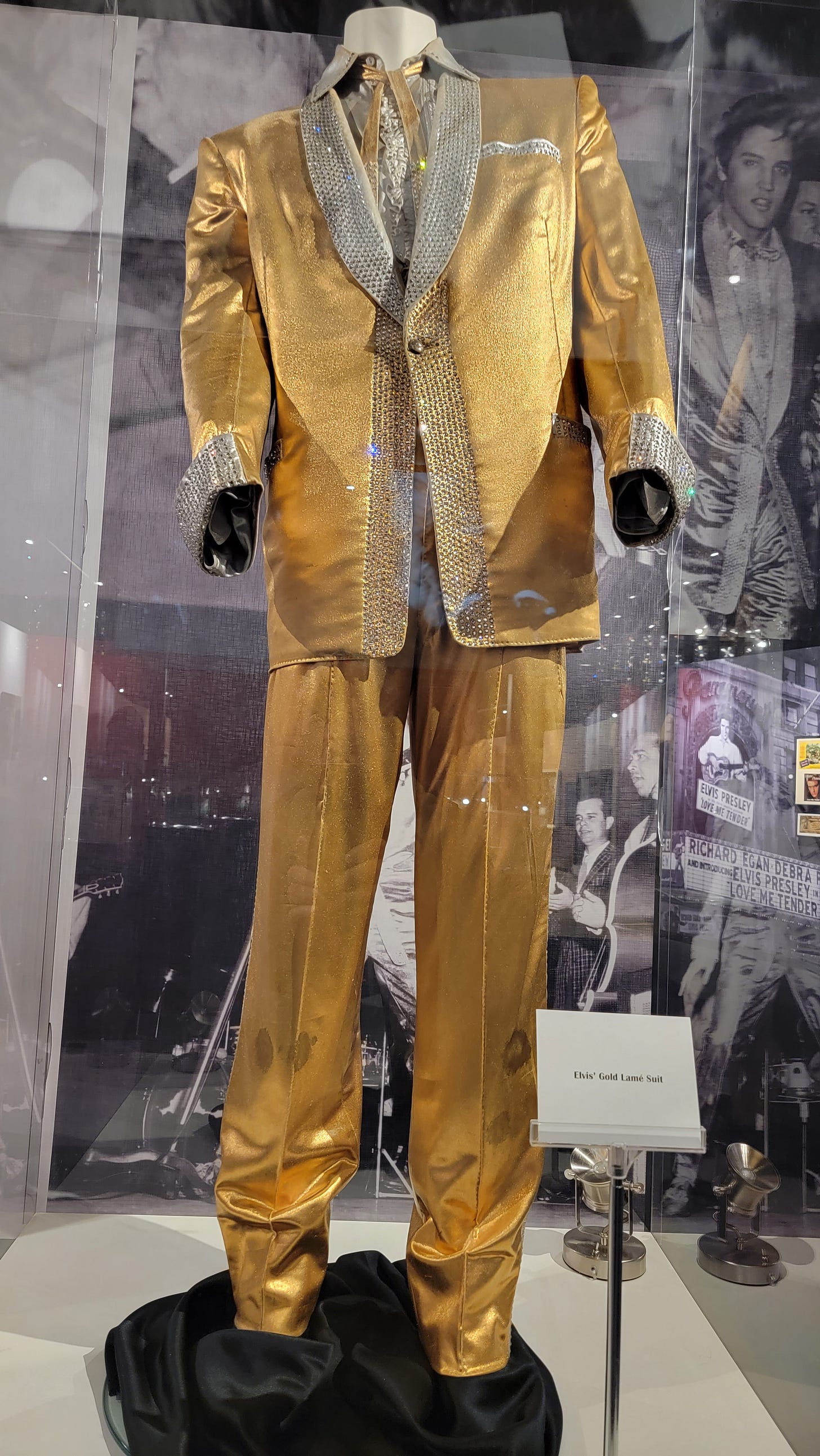

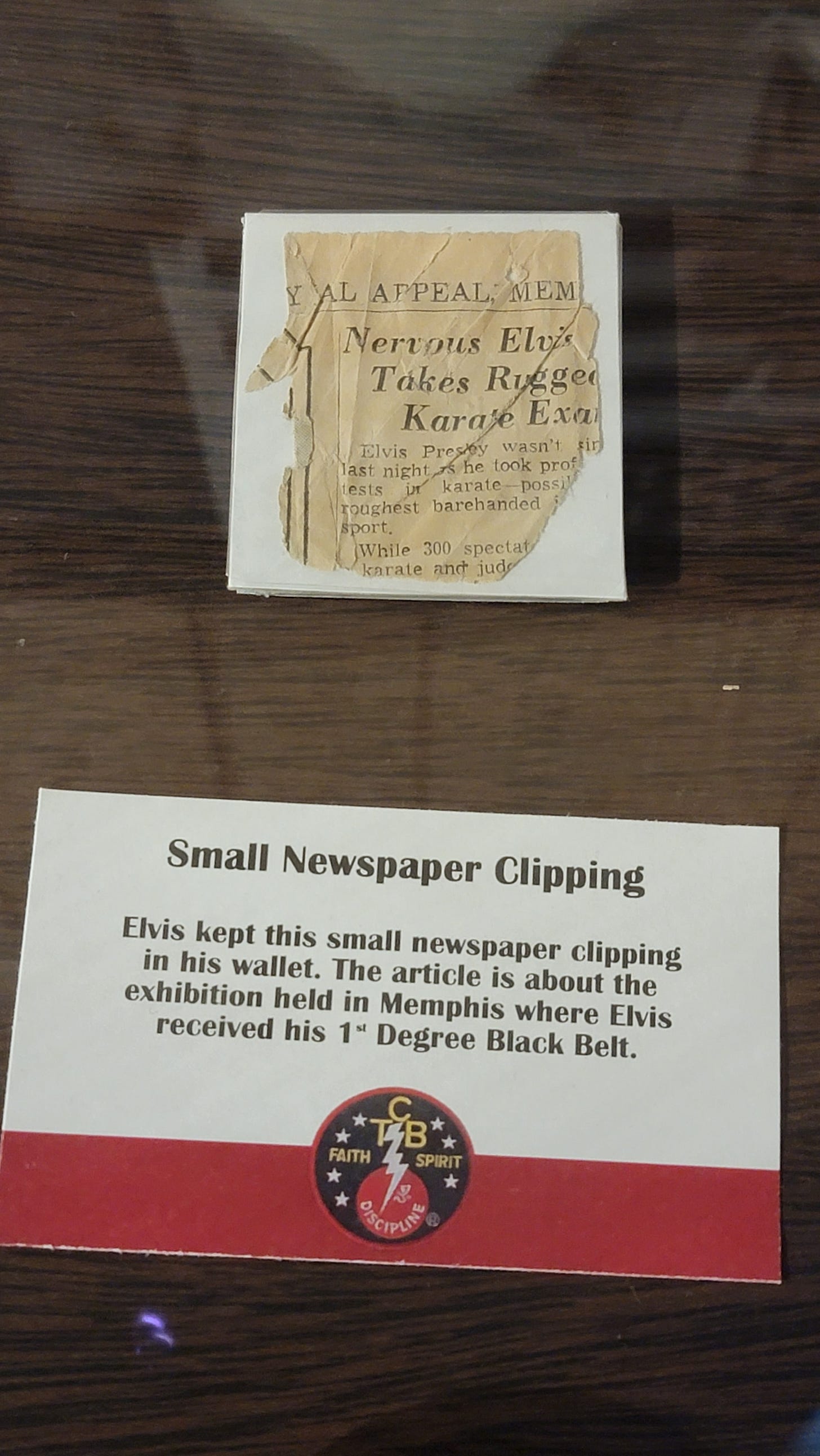
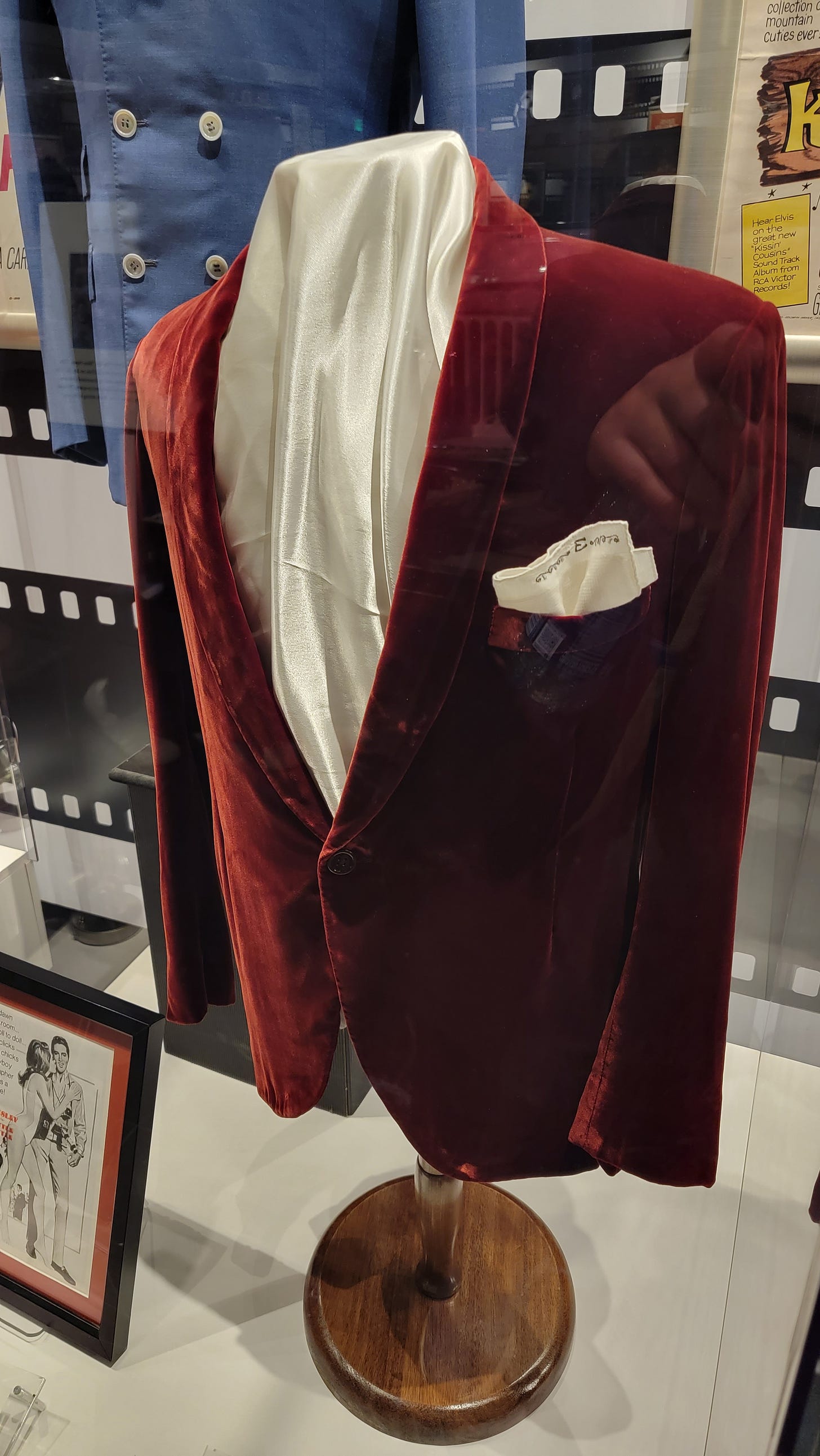
A thoughtful, passionate essay that could benefit the Graceland experience--if the powers that be are open to suggestions for enhancement.
When I prepared the Elvis 1956 presentation for the library and a mobile DJ convention, truly stunning the acceleration of Elvis' ascent from living at home, Louisiana Hayride, and packing the gear in a station wagon and traveling the South to gold records, movies, controversy, hysteria, and #1 hits. In such a compact time frame. Unfathomable. Only the Beatles in 1964 is remotely comparable.
In 2013, I had a gut feeling that the Summit High Boys' soccer team had a chance to win the state title for the first time. So, I started clipping articles and collecting OSAA standings and rankings after each game and assembling in a scrapbook. They won the state title. And, at the awards dinner, each player and coach received a copy of the scrapbook.
In my parents' garage, my father had a newspaper clipping of an article and photo of he and his brother with the largest sturgeon caught that year in the Bay Area prominently featured on the wall with his rods and reels. You noticed it when you walked in.
Not quite the same as a digital scrapbook. Thank you very much.
-30-